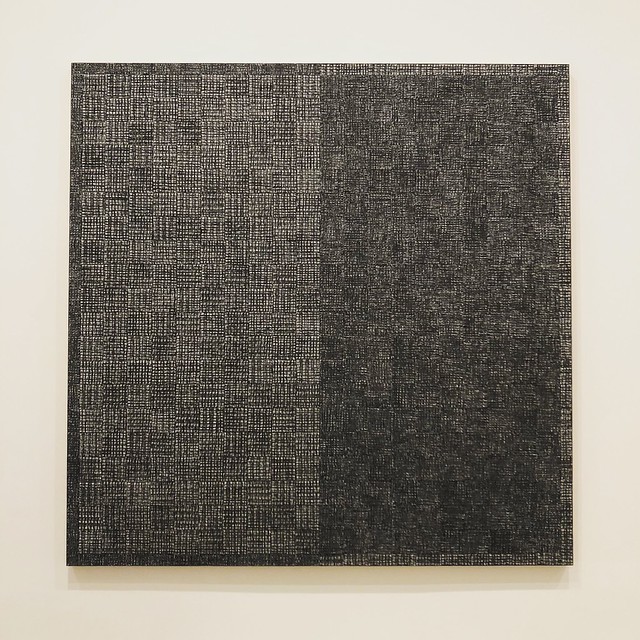Long Look: 'Route One, Box Two, V'

Route One, Box Two V
McArthur Binion
Oil stick, ink, and paper on board
2017
I adore obsessives. There is something about a person who has an obsession, about their devotion to collecting vinyl 45s, or making chocolates with flowers the size of a pencil point repeated across its surface, or motorcycles with chrome whose polish requires a kind of monastic sensibility, that has always enchanted me.
McArthur Binion’s painting, Route One, Box Two V is (by my estimation) six feet high by six feet wide. The surface is divided into squares, 20 across, and 20 high. Each of these squares is composed of an eight by eight grid, where each of the 64 smaller squares is about a quarter of an inch across.

I did the math for you. McArthur Binion individually created 28,160 individual squares - think of them as individual, tiny paintings – to make this work.
Perhaps obsession is the wrong word. Devotion, perhaps, is a better word. Devotion is a close neighbor to love, to the kind of love that causes us to lose sight of the goal. After all, who wants it to end? The glory is in the repetition; we cannot say “I love you,” too much, or hear it too much, when we are in love. Outsiders watching us might roll their eyes, see us as a cliche – and we might be a cliche, just as it’s easy to imagine this painting being cribbed by some enterprising Swedish designer as the inspiration for an IKEA duvet set. The fact that it may seem simple and repetitive makes it no less powerful for the ones who are inside the experience.
As a side note, at this writing, this work is in an anteroom alongside one of the ICA’s highest profile new acquisition: ‘Love is Calling,’ by the Japanese artist Yayoi Kusama. Repetition, even what some might call obsessiveness, is central to Kusama’s work. ‘Love is Calling’ is one of Kusama’s ‘infinity room’ works – they are installed inside a room of mirrors and appear to go on infinitely. Like love, they are bigger on the inside than the outside.

‘Love is Calling,’ Yayoi Kusama. Photo courtesy of Alcyone.
Can you say that an abstract work of art is about love, or about devotion, or about anything? Perhaps not. I do believe that the human mind loves patterns, and almost can’t help making meaning from those patterns. Take, for example, the near-universal phenomenon of pareidolia: we see faces where none are intended.
It is in this sense that I search for patterns in abstract works, and find meaning in them. If we say: this is a painting about love, what do we see?

If we think of the two halves as people, we have light and dark: opposites attract. The eye is naturally drawn to the central dividing line, a visual reminder that no matter how close we get to someone, that dividing line will always be there. Yet here, in the halo of the gallery lights, they are an eternal couple; neither death nor squabbles will ever part them. Notice, too, the border; the light one is surrounding the dark one with its light; the darker one is enveloping the lighter one in its mystery and quiet. Looking at the well defined edge of the painting reminds us to ask: what’s the difference between two people and a couple? What’s the difference between a “situationship” and a relationship?
Maybe it’s love.
